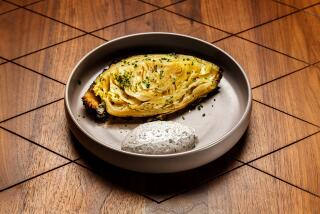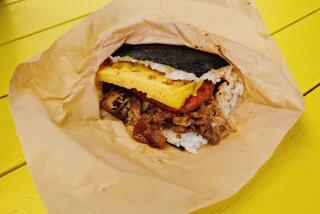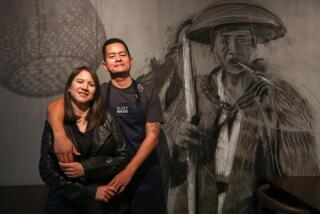MARKETS : The Kimchi Way of Life
“Some people I know eat kimchi with their hamburger instead of dill pickles,” says David Cho, who manages deliveries at Kae Sung Market, a sort of kimchi boutique.
Most non-Koreans know kimchi only as the garlicky, scorchingly hot fermented cabbage served at Korean barbecue restaurants. But there are actually hundreds of kimchis, made from all kinds of vegetables, and they range from fiery hot to very mild.
“The recipes vary regionally, seasonally and from family to family,” says Sook Jae Cho, owner of Kae Sung Market.
In its obscure location on a residential street near Koreatown, Cho, her two sisters and a small crew turn out kimchis in a spotless modern factory behind the store. Their beautifully hand-crafted assortment includes leek- and radish-stuffed baby cucumber kimchi in peppery sauce and clear “water” kimchi--halved napa cabbages layered with julienne radishes in a brine flavored with fruit juice.
Her most opulent kimchi, bo sam , was once eaten only by royalty. It’s made from perfect whole cabbage leaves stuffed with oysters, apples and Asian pears, along with pine nuts, chestnuts and jujubes. Bo sam is prepared only in the fall, when the fruits and cabbage are at their peak.
Like many women of her generation, Cho perfected her kimchi-making skills under the watchful eye of her mother and grandmother. She grew up in the North Korean city of Kae Sung in the days before the Korean War, when horse-drawn carts were still the major mode of transportation. Cho recalls how everyone in the family got involved in the kimjang , a colorful harvest-time ritual of preserving vegetables for the winter by turning them into kimchi.
During the kimjang , an endless stream of wooden-sided carts heaped with Asian cabbages or enormous white radishes would rumble in from the countryside to the open marketplace. In the stalls, masses of bright-red chiles had already been strung to dry. Tons of garlic tied into ropes would hang next to stands filled with towering stacks of green onions. Cooks swarmed through the market inspecting the booty, bargaining for the best they could get.
After days of cutting and salting vegetables, grinding pepper and peeling garlic, the family would pack the kimchis into huge porcelain Ali Baba-style jugs and bury them underground. As they slowly fermented during the icy Korean winter, the kimchis would become increasingly sour. By March everyone would be delighted to have a change--fresh-tasting new kimchis made with spring vegetables.
Throughout the Korean War, political control of Kae Sung shifted back and forth between opposing forces. But when it became clear the city was to remain part of the Communist North, Cho’s family fled south along with thousands of other Koreans.
After Cho immigrated to Los Angeles, she began making her Kae Sung-style kimchis for friends. Within the Korean community, where Kae Sung-style foods have a certain cachet, her reputation for creating fine kimchis grew. In 1974, Cho turned professional, producing her kimchis at Green Tree Korean market, where they were an immediate success with food-loving Koreans too busy to make their own.
Three-and-a-half years ago, when Cho opened Kae Sung, she added home-style cooking sauces and side dishes ( panchan ) to her repertoire. Cho’s kimchis, sauces and panchan are available at many Korean supermarkets, as well as at the store. Although bigger factories now manufacture tons of mass-produced kimchi, many discerning Koreans still prefer Cho’s elegant home-style versions--even if they’re just something to eat with a burger.
SHOPPING LIST
When kimchis were the only source of winter vegetables (and of Vitamin C), many Koreans developed a preference for the pungent, fermented winter varieties. In this country, with refrigeration and an almost year-round supply of fresh vegetables, both the winter-style and the very lightly fermented summer-style kimchis are made nearly all year, Cho says.
The shop sells kimchi fresh, but some people take their purchase home and let it sit overnight at room temperature, then keep it for a week or so in the refrigerator before eating, to get a more fermented flavor. Most kimchis can be kept refrigerated for about three weeks. “After that,” says David, Cho’s son, “they can really get a bit too strong.”
Kae Sung’s kimchis can be neatly organized into three categories:
TONGCHIMI
Originally from North Korea’s Pyongyang region, where the water is said to be exceptionally pure and the winters extremely harsh, tongchimi is the mildest and least salty of the kimchis. (In the warmer South, more salt and seasonings were added to keep the vegetables preserved.) The Korean equivalent of kosher half-dills, this is the best style for the kimchi novice.
Tongchimi is primarily made from muu , a large radish with a turnip-like texture. The long, elegant wedges of muu will share a gleaming rounded jar with spring onions, a few strips of red bell pepper and a single slice of hot green pepper in a garlicky brine. Tongchimi is best served well chilled.
Before widespread home refrigeration, housewives fermented their tongchimi underground for about a month before serving it. Veteran kimchi eaters now quick-ferment their tongchimi at room temperature overnight before refrigerating it. Cho sells tongchimi fresh, or if you request it, already fermented.
WATER KIMCHIS
Also known as mool kimchis, these are also associated with the milder and less-salty cooking of North Korea. But since the exodus of North Koreans to the South, mool kimchis have been adopted by everyone. Cho makes two of these pickles; both should be served icy cold.
* Turnip Green Water Kimchi (Putbachu Mool Kimchi) : Made in the style of Kae Sung, this particular kimchi of tender turnip leaves submerged in a lightly peppery, coral-colored brine, is flavored with pureed fresh garlic, sweet and hot red peppers and fruit juice. Traditionally it is served in a small bowl with a little brine.
* Whole Cabbage Water Kimchi (Bak Kimchi) : In tradition-bound Korea, a young woman’s marriage-ability depended on the finesse with which she could cut and arrange foods. Making a batch of bak kimchi would certainly demonstrate her skills. The radish filling, now usually produced by a machine, was once meticulously julienned by hand.
At Kae Sung the Asian cabbage halves are salted and left to soften overnight in plastic tubs. After flushing them thoroughly with water, the workers carefully sprinkle the largest leaves with a mixture of julienned radishes, a few pine nuts and green onion strips. Several of the stuffed cabbage halves are inserted into a jar and covered with brine.
When cut, this kimchi yields beautiful lasagna-like servings of cabbage layered with radish and seasonings. You peel away the top leaf and eat it first before tasting the multiple flavors of the filling.
Use tongs to remove each cabbage half from the jar and serve the kimchi sliced crosswise into broad strips. Place these cut rectangles flat side up in a small bowl with a little brine.
EXTRA-SPICY KIMCHIS
With some slight variation in seasonings, all of the following kimchis are based on a pasty brine of ground dried red pepper, mashed garlic and salt. The mixture also includes salted baby shrimp, cured yellow fish or salted anchovies, which actively ferment in the kimchi.
* Mak Kimchi : This style is simply labeled kimchi. The name is loosely translated as “anything goes” or “common” kimchi, because the cabbage is roughly chopped and tossed together with julienned radishes, perhaps a few wisps of carrot and green onion. It’s a less labor-intensive kimchi than the whole or layered varieties. Mak kimchi has a little sugar and ginger in the brine, which mellows its flavor somewhat.
* Whole Spicy Cabbage Kimchi (Poki Kimchi) : More elegant than the mak kimchi, this is a whole cabbage layered in the same manner as the cabbage water kimchi described above, and it’s served the same way too--but it’s spicier.
* Stuffed Baby Cucumber Kimchi (Oi Sobagi Kimchi) : Just about everyone loves this kimchi’s fusion of hot and cool tastes. It is one that many cooks like to make at home--if they’re up to doing all the delicate knife-work it requires. The cucumbers are slit lengthwise in two directions, stuffed with an angel-hair-fine mix of Chinese leeks and green onions and submerged in a thick peppery sauce. Most of the sauce may be brushed away before the cucumbers are served.
* Bachelor Kimchi (Chonggak Kimchi) : Thumb-length white radishes, with their long leafy stems still on, are packed into the red pepper paste with a few green onions. The radishes are slit lengthwise so the pepper sauce can penetrate. You eat this kimchi leaves and all.
* Hot Radish Kimchi (Kkaktugi Kimchi) : For this one, larger radishes are cut into small squares. It’s one of the kimchis that some people like to ferment at home.
* Texas Mustard Green Kimchi (Kat Kimchi) : One of Cho’s inventions, this kimchi is made extra hot and salty in the South Korean style. The broad, soft leaves on their long stems are packed into the seasoning, which renders them almost translucent. Unlike the firmer cabbage and turnip leaf kimchis, this one has a buttery texture with a slight crunch to the stem.
* Green Onion Kimchi (Pa Kimchi) : In place of cabbage or radishes, pa kimchi uses green onions cut into thin lengthwise strips. A bit of ginger flavors the spicy brine.
* Baby Chinese Cabbage Kimchi (Putbachu Jutgal Kimchi) : Labeled “Seasoned Cabbage” in English, this mixture of tender green-and-white Chinese cabbage leaves and a few shreds of green onion make for a less crunchy and slightly more bitter kimchi than the napa cabbage styles.
* Sesame Leaf Kimchi (Kkaennip Kimchi): These slightly tangy multi-pointed leaves go by the formal name of perilla or shiso. If you’ve tasted shiso , you know their assertive character. (These leaves really soak up the hot sauce.)
* Chinese leek kimchi: Like sesame-leaf kimchi, this salty-sweet-hot condiment will wake up your senses with its potency.
Kae Sung Market, 1010 S. St. Andrews Place, Los Angeles, (213) 737-6565. Open Monday through Saturday 8 a.m. to 7 p.m.
More to Read
Eat your way across L.A.
Get our weekly Tasting Notes newsletter for reviews, news and more.
You may occasionally receive promotional content from the Los Angeles Times.








